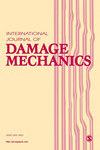Damage-healing analysis of microencapsulated self-healing concrete subjected to tensile loading using a 2D micromechanical model
IF 4
2区 工程技术
Q2 MATERIALS SCIENCE, MULTIDISCIPLINARY
引用次数: 3
Abstract
Self-healing concrete that employs microencapsulated healing agents has been proven to be an effective method for microcrack repairment in the concrete structure. However, there is a lack of efficient tools to evaluate the effect of the parameters of microcapsules on the mechanical behavior of the self-healing concrete. In this paper, the evolution of the damage-healing process of microencapsulated self-healing concrete subjected to tensile loading is numerically analyzed from a microscopic perspective by using a 2D micromechanical model. Based on the deformation and propagation evolution mechanism of microcracks, the contribution of microcracks to the total compliance tensor of microencapsulated self-healing concrete under tensile loading is deduced at various stages. According to the calculated total compliance tensor, the stress-strain and compliance-strain relations of microencapsulated self-healing concrete are discussed with special attention to the stress dropping and strain softening stages. Finally, parametric analysis was conducted using the constructed model to investigate the influence of size and content of microcapsules, the types of healing agent and the initial damage of the concrete on the mechanical behaviors of microencapsulated self-healing concrete. The constructed 2D model is significantly useful for the reasonable selection of the optimal parameters of microencapsulated self-healing concrete.微胶囊自修复混凝土在拉伸载荷作用下的损伤愈合分析
采用微胶囊修复剂的自修复混凝土已被证明是修复混凝土结构微裂纹的有效方法。然而,目前还缺乏有效的工具来评估微胶囊参数对自修复混凝土力学性能的影响。本文采用二维微力学模型,从微观角度对微胶囊自修复混凝土在拉伸载荷作用下的损伤愈合过程进行了数值分析。基于微裂纹的变形和扩展演化机制,推导了微裂纹在不同阶段拉伸载荷下对微胶囊自修复混凝土总柔度张量的贡献。根据计算出的总柔度张量,讨论了微胶囊自修复混凝土的应力-应变关系和柔度-应变关系,特别注意应力下降和应变软化阶段。最后,利用构建的模型进行了参数分析,研究了微胶囊的尺寸和含量、愈合剂的类型以及混凝土的初始损伤对微胶囊自修复混凝土力学性能的影响。所构建的二维模型对于合理选择微胶囊自修复混凝土的最佳参数具有重要意义。
本文章由计算机程序翻译,如有差异,请以英文原文为准。
求助全文
约1分钟内获得全文
求助全文
来源期刊

International Journal of Damage Mechanics
工程技术-材料科学:综合
CiteScore
8.70
自引率
26.20%
发文量
48
审稿时长
5.4 months
期刊介绍:
Featuring original, peer-reviewed papers by leading specialists from around the world, the International Journal of Damage Mechanics covers new developments in the science and engineering of fracture and damage mechanics.
Devoted to the prompt publication of original papers reporting the results of experimental or theoretical work on any aspect of research in the mechanics of fracture and damage assessment, the journal provides an effective mechanism to disseminate information not only within the research community but also between the reseach laboratory and industrial design department.
The journal also promotes and contributes to development of the concept of damage mechanics. This journal is a member of the Committee on Publication Ethics (COPE).
 求助内容:
求助内容: 应助结果提醒方式:
应助结果提醒方式:


